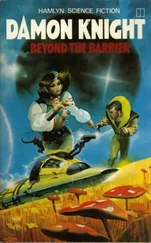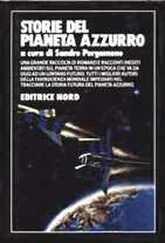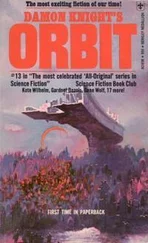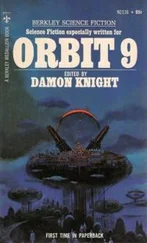Damon Knight - Orbit 21
Здесь есть возможность читать онлайн «Damon Knight - Orbit 21» весь текст электронной книги совершенно бесплатно (целиком полную версию без сокращений). В некоторых случаях можно слушать аудио, скачать через торрент в формате fb2 и присутствует краткое содержание. Год выпуска: 1980, ISBN: 1980, Издательство: Harper & Row, Жанр: Фантастика и фэнтези, на английском языке. Описание произведения, (предисловие) а так же отзывы посетителей доступны на портале библиотеки ЛибКат.
- Название:Orbit 21
- Автор:
- Издательство:Harper & Row
- Жанр:
- Год:1980
- ISBN:0-06-012426-1
- Рейтинг книги:5 / 5. Голосов: 1
-
Избранное:Добавить в избранное
- Отзывы:
-
Ваша оценка:
- 100
- 1
- 2
- 3
- 4
- 5
Orbit 21: краткое содержание, описание и аннотация
Предлагаем к чтению аннотацию, описание, краткое содержание или предисловие (зависит от того, что написал сам автор книги «Orbit 21»). Если вы не нашли необходимую информацию о книге — напишите в комментариях, мы постараемся отыскать её.
Orbit 21 — читать онлайн бесплатно полную книгу (весь текст) целиком
Ниже представлен текст книги, разбитый по страницам. Система сохранения места последней прочитанной страницы, позволяет с удобством читать онлайн бесплатно книгу «Orbit 21», без необходимости каждый раз заново искать на чём Вы остановились. Поставьте закладку, и сможете в любой момент перейти на страницу, на которой закончили чтение.
Интервал:
Закладка:
Few other swimmers were out. I swam around the break, out beyond the crater, where the swells first hit the shelf and started to rise to their full height, which today was nearly ten meters. There were three other swimmers there, and I floated on my back and waited for them to take their turns. Rising and falling on those smooth swells, I felt quite inhuman; all that I saw, felt, and heard—even the sound of my own breath—was strange, alien, too sublime for human sensibility.
Then I was alone. A swell approached and I backstroked away from it, toward the point where it would first break, adjusting my speed so I would be just ahead of that point when the wave picked me up.
The wave reached me and I felt its strong lift. I turned luxuriously onto my stomach, skimmed down the steepening face until I felt that the swell was pitching out over me. From my thighs up I was clear of the methane, skating on my handfins—I turned them left and swerved across the wave, just ahead of the break, flying, flying. ... I moved my feet to retard my speed a fraction, and the roof of the breaking wave moved ahead of me. It got dark. I was in the tube. My hands were below me, jammed into the methane to keep me from falling down the face. I was motionless yet flying, propelled through the blackness at immense speed by the liquid which rushed up past my left shoulder, arched over my head and fell out beyond my right shoulder. Before me there was a huge tunnel, and at the end of this swirling obsidian tube a small ellipse of velvet black, packed with stars.
The opening got smaller, indicating that the wave was past the submerged crater, and receding. I dropped to gain speed, turned back up and shot through the hole, over the swell and back onto the smooth glassy surface, under the night.
I swam slowly back to the point break, watching another swimmer spin silently across the next rushing wall. He rose too high and was thrown over with the lip of the wave. If he hit the crater-reef and broke the seal of his suit, he would freeze instantly—but he knew that, and would be careful to avoid being forced too deep.
I radioed the shore and had them pipe Gregorian chants into my headphones; and I swam, and rode waves, and hummed with the voices when I could catch my breath, and thought not at all. I swam till there was too much sweat in my suit, and not enough oxygen.
Back on the peoplemover, I felt good: free and self-sufficient, cosmopolitan, ready to work on the next part of the Icehenge problem. The next day I checked my mail again, just in case, and there was a note from Mark Starr, one of the variety that sent love and promised that a letter would arrive soon. Print, I typed, and out of the slot in the side of the console it appeared, blue ink on grey paper, just as always.
One day I went down to Waystation’s News and Information Center to see if the Nederland press conference I had heard about was on tape. The lobby was nearly empty, and I went directly into a booth. The index I called up listed only Nederland’s regularly scheduled lectures, and I had to search through the new entries to find the press conference I wanted. Finally I discovered it, hot out of space—it had arrived while I was searching. I typed the code to run it, and sat back in the center chair of the booth.
The room darkened. There was a click and I was in a large conference room, fully lit, filled with the holo images of Martians: reporters, students, some scientists I recognized. . . . Nederland was moving down an aisle next to me, toward a podium at the front. I moved through people and chairs to the aisle, and stood in front of Nederland. He walked through me. Smiling grimly at my ritual, and at my quick moment of involuntary fright at the unfelt collision, I muttered, “You’ll see me yet,” as I always did, and kicked about until I relocated my chair.
Nederland reached the podium and the irregular percussion of voices died. Underneath those manicured grey eyebrows there was a look of triumph, at the corners of the mouth, the tightening of a tiny smile. “You old son of a bitch,” I said. “You’ve got something up your sleeve. . . .”
He cleared his throat, his usual sign that he was taking over. “I think my statement will answer most of the questions you have today, so why don’t I start with that, and then we’ll answer any questions you might have.”
“Old fool,” I said, but it was the only response. Nederland looked down at his notes, looked up—his eyes crossed mine— and extended a benedictory hand.
“The recent critics of the Vasyutin explanation claim that the Pluto monument is a modern hoax, and that in my work on the subject I have ignored the physical evidence. The absence of any disturbance in the regolith around the site, and our inability to find any signs of construction at all, are cited as facts which contradict, or do not fit, my explanation.
“I submit that it is the critics who are ignoring the physical evidence. If the Vasyutin Expedition did not build Icehenge, why did Vasyutin himself study the megalithic cultures of Terra for six years?”
“What?” I cried.
“—what are we to make of his stated intention to leave some sort of mark on the world? Can we label it coincidence that Vasyutin’s ship disappeared just eight years before the date found on Icehenge? I think not. . . .”
He went on, outlining the arguments he had been espousing for the last sixty years. “Come on,” I shouted. “Get down to it!” He droned on, ignoring the fact that his critics had shown the whole Vasyutin story to be part of the hoax. Then he flipped over a notecard, and an involuntary smile creased his face. I sat forward.
“My critics,” he said in his let’s-be-reasonable tone, “are simply attacking in a purely destructive way. Aside from the vague claim that the monument is a modern hoax—perpetrated by whom, they cannot say—there is no theory to replace mine; and nothing to explain away the evidence found in the archives on Mars—”
“Oh, my God.”
“The general claim of people like Doya, Satawal and Jordan is that there is nothing at the site which will prove Icehenge’s age. On the other hand, there is nothing there that shows the monument to be modern, either, which, given the sophistication of dating methods, there almost certainly would be, if it were indeed modern.
“In fact, there is now evidence conclusively proving that Icehenge cannot be modern.” He stopped to let the statement sink in. “You are all aware that micrometeors, the dusty debris of space, are continually falling on all the bodies of the solar system; and that when they fall on those bodies without an atmosphere, they leave minuscule craters. Even the smallest of fragments leave their mark. The fall of these micrometeors is regular, and is a constant throughout the system. Professor Mund Stallworth, of our own University of Mars, has received a grant from the Holmes Foundation, and he has done extensive work in this field. He has established rates of fall for different gravities, and thus a micrometeor count can now be used as an accurate dating method. Professor Stallworth has made a detailed computer scan of the exposed faces of the liths, and of the surrounding grounds, which the builders swept clear; and the count is such that he puts the date of the erection of Icehenge at a thousand years before the present, plus or minus five hundred years. It is impossible to be more precise with the short time spans involved. This places the latest date of construction one hundred and fifty years before the date left on the Inscription Lith; but this may be explained by the fact that every blemish on the smooth surfaces of the liths can be clearly seen. In any case, it is impossible that so many micrometeors could have fallen in the short amount of time postulated by those who think that Icehenge is a hoax.
Читать дальшеИнтервал:
Закладка:
Похожие книги на «Orbit 21»
Представляем Вашему вниманию похожие книги на «Orbit 21» списком для выбора. Мы отобрали схожую по названию и смыслу литературу в надежде предоставить читателям больше вариантов отыскать новые, интересные, ещё непрочитанные произведения.
Обсуждение, отзывы о книге «Orbit 21» и просто собственные мнения читателей. Оставьте ваши комментарии, напишите, что Вы думаете о произведении, его смысле или главных героях. Укажите что конкретно понравилось, а что нет, и почему Вы так считаете.












